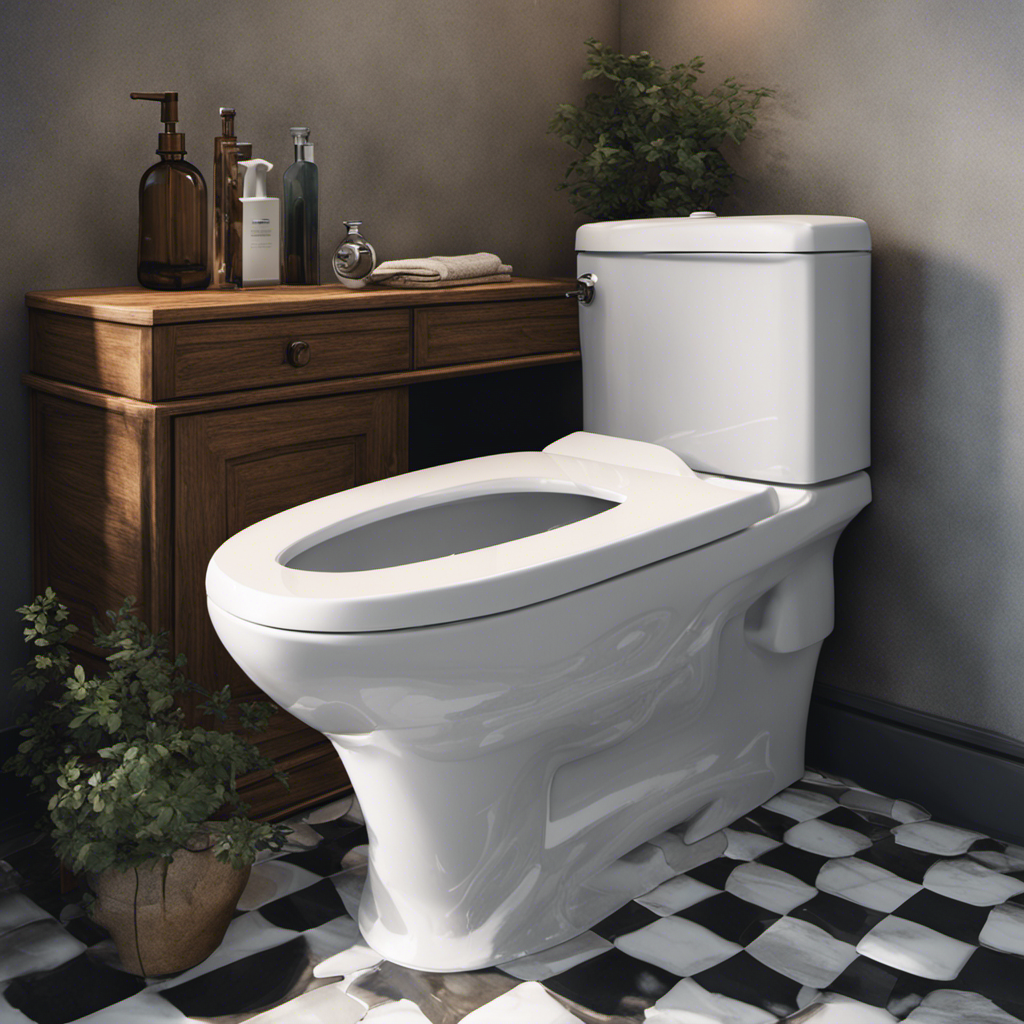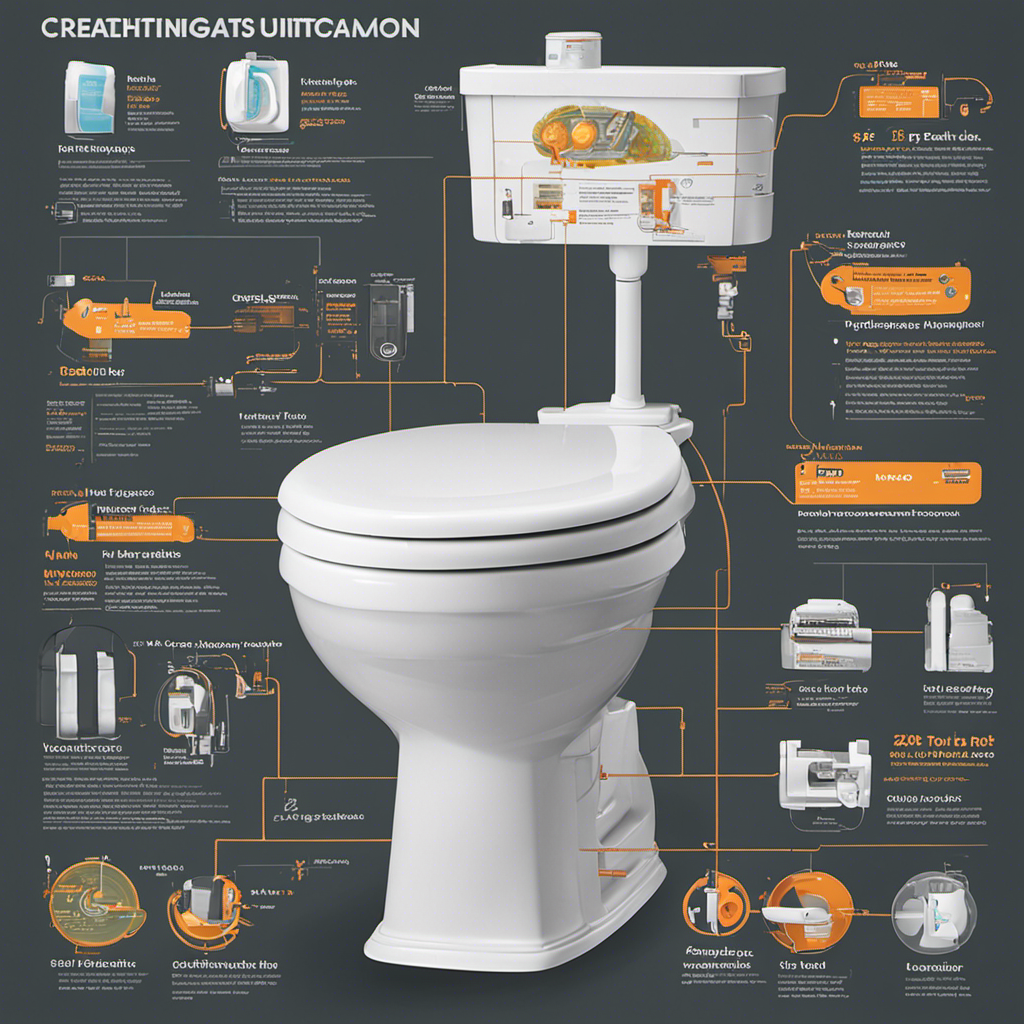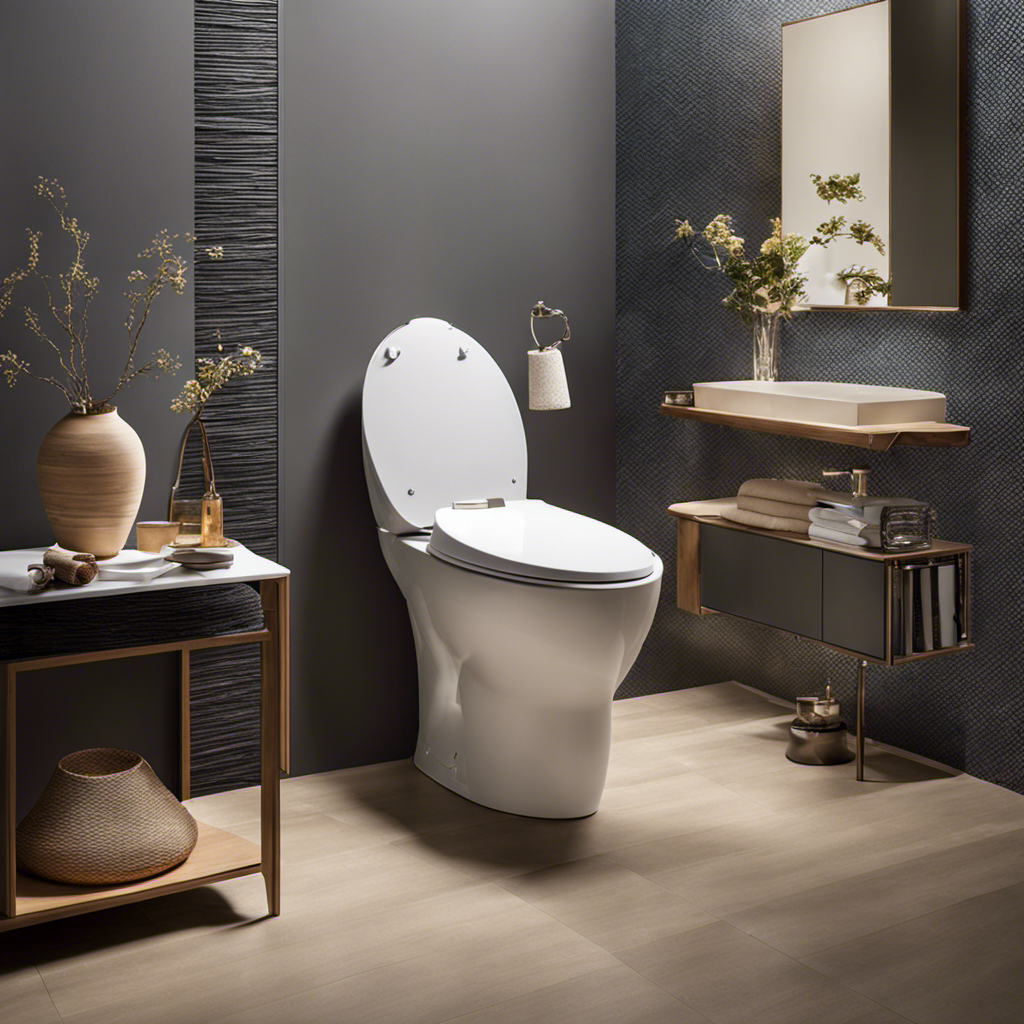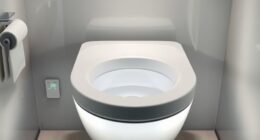I’m constantly amazed at how a simple toilet can cause such a big headache when it starts running non-stop. It’s like a marathon that never ends!
But fear not, because in this article, I’ll be sharing all the knowledge, precise details, and step-by-step instructions you need to fix this common plumbing issue.
From identifying faulty flapper valves to troubleshooting other potential problems, you’ll be able to stop that running toilet in its tracks and enjoy some well-deserved peace and quiet.
Key Takeaways
- The most common cause of a running toilet is a faulty flapper valve, which can be identified by visible signs of wear or deterioration, cracks or tears in the flapper. The flapper valve controls water flow and its malfunction leads to continuous water flow.
- Other causes of a running toilet include a damaged fill valve, faulty flush valve, and malfunctioning float assembly. Troubleshooting and repairing these components may be necessary.
- Adjusting the water level in the tank is important to prevent weak flushes and constant running. This can be done by adjusting the fill valve or float, and it also contributes to water conservation.
- Troubleshooting and repairing other toilet issues such as high water consumption and bills, low water level, constant running, environmental impact, and financial impact may involve repairing a faulty fill valve, replacing a damaged flush handle, checking for leaks, and ensuring proper water pressure.
Common Causes of a Running Toilet
One common cause of a running toilet is a faulty flapper that needs to be replaced. The flapper is a rubber valve located at the bottom of the toilet tank. Its purpose is to regulate the flow of water from the tank into the toilet bowl.
When the flapper becomes worn or damaged over time, it may not create a proper seal, allowing water to continuously leak into the toilet bowl. This constant flow of water leads to a running toilet and can waste a significant amount of water.
To identify a faulty flapper valve, one should check for visible signs of wear or deterioration, such as cracks or tears. Additionally, listening for a continuous hissing sound or observing water constantly running into the bowl are also indicators of a faulty flapper valve.
Transitioning into the subsequent section, it is important to understand the steps to replace a faulty flapper valve.
Identifying a Faulty Flapper Valve
As a plumbing expert, I’m well-versed in the common causes of a running toilet and how to fix them.
One of the key components to inspect when facing this issue is the flapper valve. Flapper valve malfunctions can often be the culprit behind a running toilet.
I will guide you through identifying the signs of a faulty flapper valve and providing step-by-step instructions on how to fix it.
Flapper Valve Malfunctions
When the toilet’s running, it’s usually because the flapper valve isn’t working properly. The flapper valve is responsible for controlling the flow of water from the tank into the bowl. If it malfunctions, it can result in a continuous flow of water, causing the toilet to run.
To address this issue, there are two options: toilet flapper replacement or toilet flapper repair.
Toilet flapper replacement:
- Turn off the water supply to the toilet.
- Remove the old flapper valve by disconnecting it from the flush valve.
- Install the new flapper valve by attaching it to the flush valve.
- Turn on the water supply and test the toilet to ensure it’s functioning properly.
Toilet flapper repair:
- Inspect the flapper valve for any visible damage or debris.
- Clean the flapper valve thoroughly to remove any build-up.
- Check the chain or linkage connected to the flapper valve for any issues.
- Adjust the chain or linkage if necessary.
- Test the toilet to see if the repair has resolved the running issue.
Causes of Running Toilet
To address the causes of a running toilet, it’s important to identify any issues with the flapper valve or other components. When it comes to troubleshooting toilet repair, there are several potential causes of toilet leakage that can lead to a running toilet.
One common cause is a faulty flapper valve. This valve is responsible for sealing the tank and preventing water from continuously flowing into the bowl. If the flapper valve is worn out or misaligned, it may not create a proper seal, causing water to continuously leak into the bowl.
Other potential causes of a running toilet include a damaged fill valve, a faulty flush valve, or a malfunctioning float assembly. By carefully inspecting these components and making the necessary repairs or replacements, you can effectively stop your toilet from running and prevent water wastage.
How to Fix
You can easily fix the issue by checking the flapper valve, fill valve, flush valve, and float assembly for any damage or misalignment.
To fix the problem of a running toilet, follow these steps:
-
Check the flapper valve:
-
Ensure that it is properly sealing the flush valve opening.
-
Look for any signs of damage or wear.
-
Inspect the fill valve:
-
Make sure it is adjusted correctly to control the water level in the toilet cistern.
-
Look for any leaks or water leakage around the fill valve.
By carefully examining these components and addressing any issues, you can effectively fix a running toilet and prevent water wastage.
Now, let’s move on to the next section, where I will explain how to fix a stuck float.
Fixing a Stuck Float
The first step in fixing a stuck float is to turn off the water supply to the toilet. This is crucial to prevent any water leakage or further damage.
Once the water supply is turned off, you can begin troubleshooting the issue. Start by inspecting the float and the attached arm for any obstructions or debris. If you notice any, remove them carefully.
Next, check the float’s position. It should be sitting parallel to the water level. If it’s not, try adjusting the float arm or the float itself until it is in the correct position.
If these steps don’t resolve the issue, you may need to replace the float altogether. Remember, fixing a leaking pipe and troubleshooting a toilet flush require careful attention to detail and patience.
Adjusting the Water Level in the Tank
Adjusting the water level in the tank is an important aspect of maintaining a properly functioning toilet.
There are several methods for adjusting the water level, including adjusting the fill valve or the float.
It’s crucial to ensure that the water level is set correctly, as incorrect levels can lead to issues such as weak flushes, constant running, or even water overflow.
Water Level Adjustment Methods
To fix a running toilet, try adjusting the water level using one of these methods.
First, locate the water level adjustment screw, usually found on the fill valve. Turn the screw clockwise to lower the water level or counterclockwise to raise it.
Another method is to adjust the float ball or cup. If using a float ball, bend the rod holding it to change the water level. For a float cup, squeeze the clip and slide it up or down the rod.
It’s important to find the right water level to prevent constant running and wasted water. By properly adjusting the water level, you not only fix the problem but also ensure efficient toilet operation and contribute to water conservation, which is essential in today’s eco-conscious world.
Remember these toilet maintenance tips and water-saving techniques to keep your bathroom functioning optimally.
Impact of Incorrect Levels
Make sure you check the water level regularly to avoid potential issues that can arise from incorrect levels. Maintaining the correct water level in your toilet is crucial for efficient flushing and preventing water waste. When the water level is too high, it can lead to constant running, resulting in unnecessary water consumption and higher water bills. On the other hand, if the water level is too low, it may not provide enough water for a complete flush, leading to multiple flushes and wasting even more water. The impact of water waste can be significant, both for the environment and your wallet. Constantly running toilets can waste hundreds of gallons of water per day, which not only increases your water bill but also contributes to water scarcity and environmental degradation. So, it is essential to address any issues with incorrect water levels promptly to avoid the cost of constant running and the impact of water waste.
| Issue | Impact | Solution |
|---|---|---|
| High Water Level | Increased water consumption and bills | Adjust the water level float or replace faulty components |
| Low Water Level | Inefficient flushing, multiple flushes | Adjust the water level float or replace faulty components |
| Constant Running | Excessive water waste, higher water bills | Identify and fix the underlying issue, such as a faulty flapper or fill valve |
| Environmental Impact | Water scarcity, environmental degradation | Conserve water by fixing running toilets and practicing water-saving habits |
| Financial Impact | Higher water bills, wasted money | Address running toilets promptly to save on water costs and prevent unnecessary expenses |
Repairing a Faulty Fill Valve
You can easily fix a faulty fill valve by replacing it with a new one. The fill valve is responsible for regulating the water level in your toilet tank. When it malfunctions, it can cause issues such as constant running or inadequate filling of the tank.
To troubleshoot fill valve problems, consider the following:
- Check for water leaks around the fill valve.
- Ensure that the water supply to the toilet is turned off before replacing the valve.
Replacing a fill valve involves a few simple steps:
- Remove the old fill valve by disconnecting it from the water supply line.
- Install the new fill valve by connecting it to the water supply line and securing it in place.
- Turn on the water supply and test the toilet to ensure proper functioning.
By following these steps, you can effectively resolve fill valve issues and restore the proper functioning of your toilet.
Now, let’s move on to the next section about replacing a damaged flush handle.
Replacing a Damaged Flush Handle
Replacing a damaged flush handle is a simple task that can be done in just a few steps.
First, turn off the water supply to the toilet by shutting off the valve located on the wall behind the toilet.
Next, remove the tank lid and locate the flush handle on the front of the toilet. Unscrew the nut holding the handle in place and carefully remove the old handle. Take note of the orientation of the old handle before removing it to ensure proper installation of the new handle.
Once the old handle is removed, attach the new handle by screwing the nut back on.
Finally, turn on the water supply and test the new flush handle to ensure it is working properly.
Troubleshooting flush handle problems is important to prevent further damage and ensure a properly functioning toilet.
Troubleshooting Other Potential Issues
Now let’s address some other potential issues that may be causing problems with your toilet. When troubleshooting water pressure, it’s important to check for leaks.
Leaks can affect the overall functioning of your toilet and cause it to run continuously. Here are some steps you can take to identify and fix any leaks:
- Inspect the toilet tank and bowl for any visible signs of leaks, such as water pooling around the base.
- Check the water supply line and connections for any loose or damaged parts.
- Use food coloring or a dye tablet to perform a dye test. Place the dye in the tank and wait for a few minutes. If the water in the bowl changes color, it indicates a leak.
Frequently Asked Questions
How Can I Tell if the Toilet Is Running?
To determine if a toilet is running, I can look for signs such as continuous water flow in the bowl, a hissing sound, or a constantly moving water meter. These are reliable ways to detect a running toilet.
Why Is It Important to Fix a Running Toilet?
Addressing a running toilet immediately is crucial. Ignoring it is like leaving a faucet on, wasting gallons of water. Fixing it not only saves water, but also prevents high water bills and potential damage to your plumbing system.
Can a Running Toilet Increase My Water Bill?
Yes, a running toilet can increase your water bill. To troubleshoot a running toilet, check the flapper, fill valve, and overflow tube. Common causes include a worn flapper, faulty fill valve, or an improperly adjusted float.
Are There Any Temporary Fixes for a Running Toilet?
There are temporary solutions or quick fixes available for a running toilet. These can help address the issue until a permanent repair is done. It’s important to fix the problem promptly to avoid water waste.
What Tools Do I Need to Repair a Running Toilet?
Toilet repair steps require a few common tools. First, shut off the water supply. Then, check the flapper and fill valve for any issues. Adjust or replace them if necessary. Finally, turn the water back on and test the toilet.
Conclusion
In conclusion, repairing a running toilet can be a simple task with the right knowledge and tools.
By identifying common causes like a faulty flapper valve or a stuck float, you can easily fix the issue and prevent water wastage.
Just like a skilled plumber with a trusty toolkit, you too can become the master of your own bathroom.
So don’t let a running toilet drain your patience, take charge and fix it like a pro!









